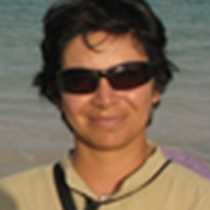Bartolome & Santiago Islands
We started our approach to Bartolome Island last night, after an amazing afternoon yesterday on North Seymour Island. This morning we headed ashore before breakfast, to climb 372 steps all the way to the top of Bartolome. Our goal was to reach the summit for the spectacular and most famous panoramic view of the archipelago. Along our hike we observed several volcanic formations of twisted ropy pahoehoe lava, scoria cones, and among this barren landscape, we noted a few species of pioneer plants fighting to survive. There were no signs of freshwater anywhere; soon though, the rainy season should begin, bringing much needed rain to the islands. Any rain that falls on Bartolome will be quickly absorbed as the volcanic terrain on this island is very porous.
We were fascinated this morning with the isolation and the silence around us. This increases the oddness we feel when we see small cactus growing out of lava or large prickly pear cactus trees growing along the shore where mangroves are also found and where one may encounter a penguin. Surprisingly all these species are found here in the same area!
After breakfast we were fitted in wetsuits and snorkeling gear and went to explore both land and sea. Our successful morning hike to the southern beach of Bartolome included finding green sea turtles trying to mate, evidence of new nests that were recently made and signs of young turtles that had hatched and rushed down to the sea. An American oystercatcher was nesting, and boobies and pelicans dove for food in the rich waters around this island. Those who returned to the landing beach, and entered the chilly but clear water to snorkel, saw white-tipped reef sharks, huge schools of both salemas and grunts, and brightly colored parrot fish.
In the afternoon, after a smooth navigation along the north side of the island, we arrived to James Island which was once a favorite hiding place for pirates and privateers. This island was named after King James I of England. Several explorers found fragments of pottery, daggers, and other artifacts left by these early visitors. Stories suggest that there could be hidden treasures here; many people have looked for them but with no luck at all thus far.
We searched for other treasures; the kind that only nature can offer. We walked where Charles Darwin may have walked when he spent nine days camped on the Island of James in 1838. Here we encountered Galápagos sea lions, Galápagos fur seals, Galápagos hawks, Darwin’s finches and lots of marine iguanas feeding and basking in the last rays of the sun. This was an afternoon of discovery and we felt joy with each new encounter. We were surrounded by a variety of animal species – mammals, reptiles and birds – and we were ignored, or possibly just accepted, by all of them. It was enchanting to be a part of their world.
We started our approach to Bartolome Island last night, after an amazing afternoon yesterday on North Seymour Island. This morning we headed ashore before breakfast, to climb 372 steps all the way to the top of Bartolome. Our goal was to reach the summit for the spectacular and most famous panoramic view of the archipelago. Along our hike we observed several volcanic formations of twisted ropy pahoehoe lava, scoria cones, and among this barren landscape, we noted a few species of pioneer plants fighting to survive. There were no signs of freshwater anywhere; soon though, the rainy season should begin, bringing much needed rain to the islands. Any rain that falls on Bartolome will be quickly absorbed as the volcanic terrain on this island is very porous.
We were fascinated this morning with the isolation and the silence around us. This increases the oddness we feel when we see small cactus growing out of lava or large prickly pear cactus trees growing along the shore where mangroves are also found and where one may encounter a penguin. Surprisingly all these species are found here in the same area!
After breakfast we were fitted in wetsuits and snorkeling gear and went to explore both land and sea. Our successful morning hike to the southern beach of Bartolome included finding green sea turtles trying to mate, evidence of new nests that were recently made and signs of young turtles that had hatched and rushed down to the sea. An American oystercatcher was nesting, and boobies and pelicans dove for food in the rich waters around this island. Those who returned to the landing beach, and entered the chilly but clear water to snorkel, saw white-tipped reef sharks, huge schools of both salemas and grunts, and brightly colored parrot fish.
In the afternoon, after a smooth navigation along the north side of the island, we arrived to James Island which was once a favorite hiding place for pirates and privateers. This island was named after King James I of England. Several explorers found fragments of pottery, daggers, and other artifacts left by these early visitors. Stories suggest that there could be hidden treasures here; many people have looked for them but with no luck at all thus far.
We searched for other treasures; the kind that only nature can offer. We walked where Charles Darwin may have walked when he spent nine days camped on the Island of James in 1838. Here we encountered Galápagos sea lions, Galápagos fur seals, Galápagos hawks, Darwin’s finches and lots of marine iguanas feeding and basking in the last rays of the sun. This was an afternoon of discovery and we felt joy with each new encounter. We were surrounded by a variety of animal species – mammals, reptiles and birds – and we were ignored, or possibly just accepted, by all of them. It was enchanting to be a part of their world.




